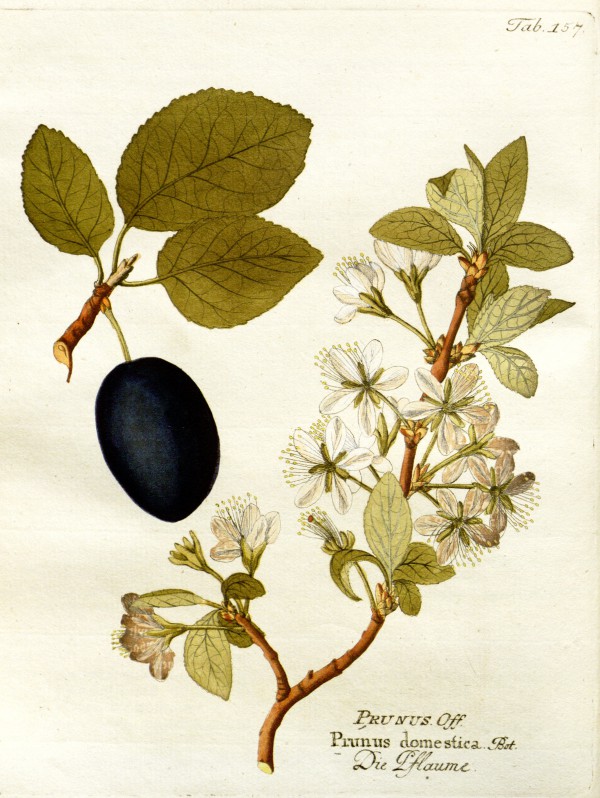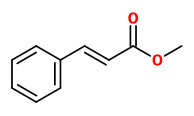Prunus domestica L. - Rosaceae - (European) plum, Pflaume, Pflaumenbaum
Deciduous tree, with a „long history of cultivation, and many horticultural varieties. It is grown for its fruit, which are eaten fresh or made into juice or preserves.“ http://www.efloras.org/florataxon.aspx?flora_id=2&taxon_id=200011157
There are some subspecies:
- Prunus domestica subsp. domestica (common plums, Zwetschge)
- Prunus domestica subsp. insititia (damsons and bullaces, Krieche, Haferpflaume)
- Prunus domestica subsp. italica (greengages, Reineclaude)
- Prunus domestica subsp. syriaca (or Prunus domestica subsp. insititia cv.Syriaca, yellow plum, Mirabelle)
Of the volatiles present in a distillate from fermented plum juice, benzaldehyde, linalool, methyl cinnamate and γ-decalactone are believed (from odour evaluation of the gas chromatographic effluent) to make significant contribution to the plum-like character. „Of particular interest also is the presence of eugenol, rather than methyleugenol, reported in unfermented juice distillates.“
[Ismail, Hanna MM, Anthony A. Williams, and Owen G. Tucknott. „The flavour components of plum.“ Zeitschrift für Lebensmitteluntersuchung und-Forschung A 171.1 (1980): 24-27]
„Qualitative and quantitative examination of the aromas above four cultivars of intact plums, using gas chromatography and gas chromatography-mass spectrometry, gave information on 33 components of which linalool, benzaldehyde, methyl cinnamate and y-decalactone were present in regions of the chromatogram associated with plum-like aromas. Comparison of the analytical data with the scoring of plum-like character by sensory means showed that the percentage concentration of these compounds only related approximately to the sensory scores, whereas the percentage of hexanol, the major component present in the extracts, was inversely related.“
[Ismail, Hanaa MM, Anthony A. Williams, and Owen G. Tucknott. „The flavour components of plums: an examination of the aroma components present in the headspace above four cultivars of intact plums, Marjorie's seedling, Merton Gem, NA 10 and Victoria.“ Journal of the Science of Food and Agriculture 32.5 (1981): 498-502]
„Vacuum steam distillation followed by solvent extraction, chemical separation and examination of the final extract by gas chromatography, and gas chromatography-mass spectrometry, enabled 73 volatile components to be identified in juices prepared from plums of the cultivar Victoria. Of these, odour evaluation of the gas chromatographic exit as the components were being separated, indicated that benzaldehyde, linalool, ethyl nonanoate, methyl cinnamate and γ-decalactone contribute to ‚plum’ aroma. Milling the plums, as opposed to merely removing the stones prior to enzyming and expressing the juice, increased the concentrations of hexanol and cis 3-hexenol and also produced hexanal and trans 2-hexenal, these four components giving rise to the characteristic ‚green’ aroma of juice prepared in this way.“
[The flavour of plums (Prunus domestica L.). An examination of the aroma components of plum juice from the cultivar victoria. Ismail, H. M., Williams, A. A., Tucknott, O. G., Journal of the Science of Food and Agriculture, Vol.32(6), 1981, 613-619]
„Volatile fractions were prepared from five ripe commercial plum cultivars and one breeding line by continuous vacuum steam distillation-hexane extraction and analyzed by capillary GC and GC-MS. Thirty-six compounds were identified. The eight major compounds for most cultivars were hexenal, butyl acetate, (E)-2-hexenal, butyl butyrate, hexyl acetate, linalool, γ-decalactone, and γ-dodecalactone. Minor constituents included eleven esters, two alcohols, four lactones, two terpenes, two saturated hydrocarbons, palmitic acid, three phenyl compounds and nonanal.“
[Comparison of the volatile compounds from several commercial plum cultivars., Horvat, R. J., Chapman, G. W., Senter, S. D., Norton, J. D., Okie, W. R., Robertson, J. A., Journal of the Science of Food and Agriculture, Vol.60(1), 1992, 21-23]
Three major compounds identified in dried prunes aroma were benzaldehyde, furfural and ethyl cinnamate.
[Volatile changes during dehydration of d'Agen prunes., Sabarez, H. T., Price, W. E., Korth, J., Journal of agricultural and food chemistry, 48(5), 2000, 1838-1842]
„Simultaneous Distillation-Extraction (SDE) and headspace-solid phase microextraction (HS-SPME) combined with GC-FID and GC-MS were used to analyze volatile compounds from plum (Prunus domestica L. cv. Horvin) and to estimate the most odor-active compounds by application of the Odor Activity Values (OAV). … Of the 148 constituents identified in plums, only 38 compounds had concentrations higher than their odor thresholds (OAV >1). The highest OAV were calculated for ethyl 2-methylbutanoate (1837), hexyl acetate (1702), and (E)-2-nonenal (1485). Ethyl 2-methylbutanoate has a green-fruity odor, reminiscent of the peels of unripe plums; hexyl acetate has a sweet-fruity berry, and pear-like odor, while (E)-2-nonenal has a waxy and slightly green odor. Relatively high odor activity values were also calculated for ethyl butanoate (847), (E)-2-decenal (357), ethyl hexanoate (323), nonanal (300), decanal (260), and (E)-β-ionone (190) with OAVs between 100 and 900. With odor activity values between 10 and 100, γ-dodecalactone, (Z)-3-hexenyl acetate, pentyl acetate, linalool, γ-decalactone, butyl acetate, limonene, propyl acetate, δ-decalactone, and diethyl sulfide should also contribute to plum aroma. On the other hand, the concentrations of (E)-2-hexenyl acetate, ethyl heptanoate, (Z)-3-hexenol, (Z)-3-hexenyl hexanoate, eugenol, (E)-2-hexenal, ethyl pentanoate, hexyl 2-methylbutanoate, isopentyl hexanoate, 1-hexanol, γ-nonalactone, myrcene, octyl acetate, phenylacetaldehyde, 1-butanol, isobutyl acetate, (E)-2-heptenal, octadecanal, and nerol were only slightly above their threshold values.“
[Study of the volatile compounds from plum (Prunus domestica L. cv. Horvin) and estimation of their contribution to the fruit aroma., Pino, J. A., Quijano, C. E., Food Science and Technology (Campinas), Vol.32(1), 2012, 76-83]
http://www.scielo.br/scielo.php?pid=S0101-20612012000100012&script=sci_arttext&tlng=es

Vietz, F.B., Icones plantarum medico-oeconomico-technologicarum, vol.2 t.157 (1804)
http://plantgenera.org/illustration.php?id_illustration=152346
Prunus domestica © Rolf Marschner (2006),
www.botanische-spaziergaenge.at




